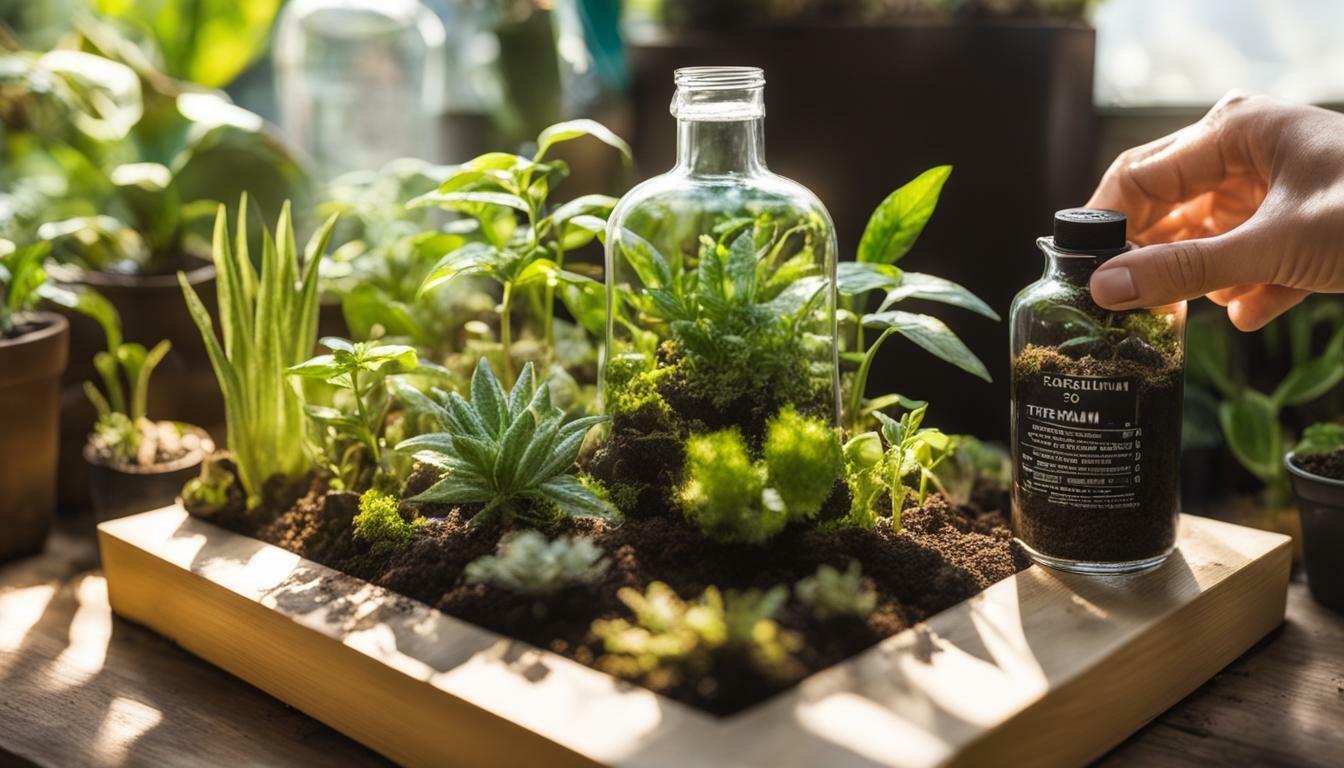Terrariums are miniature ecosystems that require careful attention to maintain the health and vitality of the plants within them. One crucial aspect of terrarium care is fertilizing the plants, as it provides essential nutrients for their growth and overall well-being.
- Terrariums require knowledge of plants, light, soil, and water for proper care.
- Light is essential for terrarium plants, but it’s important to provide the right amount for optimal growth.
- Choosing the right soil type is crucial, as it acts as a reservoir for water and nutrients.
- In bioactive setups, monitoring soil conditions is necessary, and occasional fertilization may be required.
- Watering requirements vary for different plants, so it’s essential to know their specific needs.
Understanding Terrarium Plant Nutrition
To ensure the success of your terrarium, it is crucial to understand the specific nutritional requirements of the plants you have chosen and how to meet them effectively. Terrarium plants rely on a balanced intake of nutrients for healthy growth and development. In this section, we will explore the importance of terrarium plant nutrition and discuss organic fertilizers and growth enhancers that can help meet the nutritional needs of your plants.Terrarium plant nutrition is essential for providing the necessary elements for photosynthesis, root development, and overall plant health. Understanding the specific nutrient requirements of your plant species will help you choose the right fertilizers and feed your terrarium plants appropriately. Different plants have varying needs for macronutrients, such as nitrogen (N), phosphorus (P), and potassium (K), as well as micronutrients like iron (Fe), magnesium (Mg), and zinc (Zn).
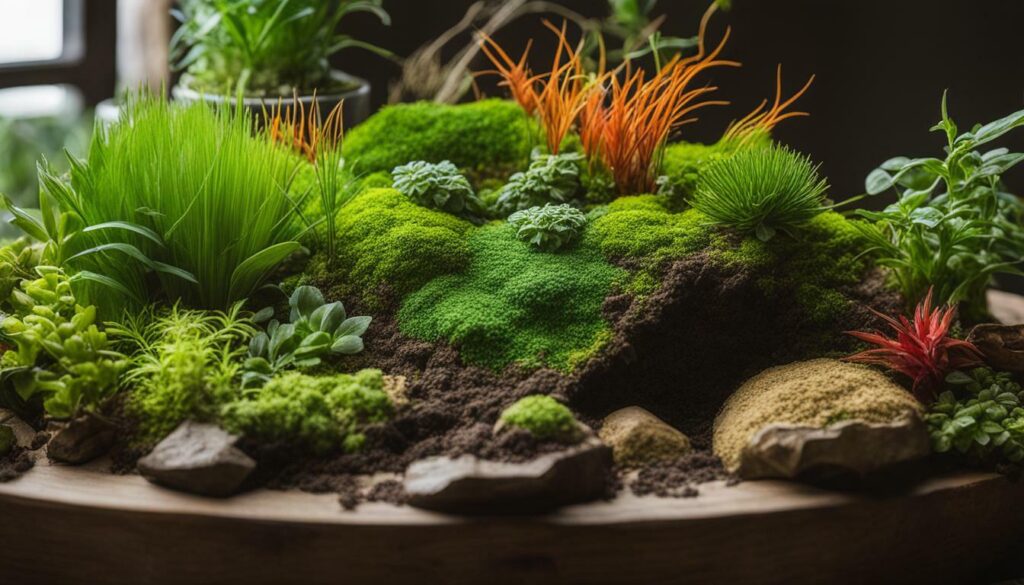
Organic fertilizers for terrariums are an excellent choice for providing sustained nutrition to your plants. They contain natural ingredients that enhance soil fertility and enrich the ecosystem within your terrarium. Organic options like compost, worm castings, and seaweed extracts are rich in essential nutrients and help promote long-term plant growth without the risk of harsh chemicals or synthetic additives.
Table 1: Comparison of Organic Fertilizers for Terrariums
| Organic Fertilizer | Nutrient Content | Benefits |
|---|---|---|
| Compost | Rich in organic matter, nitrogen, phosphorus, and potassium | Improves soil structure, enhances nutrient availability, promotes microbial activity |
| Worm Castings | High in nitrogen, phosphorus, potassium, and beneficial microorganisms | Provides slow-release nutrients, improves soil fertility, suppresses plant diseases |
| Seaweed Extracts | Contains trace minerals, growth hormones | Stimulates root development, enhances plant resilience, improves overall plant health |
In addition to organic fertilizers, there are various terrarium plant growth enhancers available in the market. These products are specially formulated to provide targeted nutrients and supplements that can accelerate plant growth and improve vitality. They often contain micronutrients, natural growth hormones, and beneficial bacteria that support root development, enhance nutrient absorption, and boost overall plant health.
To meet your terrarium plants’ nutritional needs effectively, consider a combination of organic fertilizers and growth enhancers. Monitor your plants’ growth, observe any signs of nutrient deficiencies (such as yellowing leaves or stunted growth), and adjust your fertilization routine accordingly. With the right nutrients and care, your terrarium plants will thrive and create a beautiful, vibrant ecosystem.
Choosing the Right Fertilizers for Terrariums
Choosing the right fertilizers for your terrarium is vital to provide the necessary nutrients without risking harm to the delicate balance within the ecosystem. Organic fertilizers are an excellent option for terrariums as they provide slow and steady release of nutrients, promoting healthy plant growth. They are also environmentally friendly and help maintain the overall sustainability of your terrarium. When selecting fertilizers, it’s important to consider the specific needs of your plants and the type of terrarium setup you have.
For terrariums with tropical plants, a balanced fertilizer with equal amounts of nitrogen, phosphorus, and potassium (NPK) is generally recommended. Look for organic fertilizers that contain natural ingredients such as seaweed, bone meal, or fish emulsion. These ingredients provide essential nutrients and micronutrients, supporting the growth and development of your terrarium plants.
If you have succulent or cacti plants in your terrarium, opt for a fertilizer with a lower nitrogen content, as these plants require less nitrogen to thrive. Look for a fertilizer specifically formulated for succulents and cacti, ensuring it provides the right balance of nutrients for these unique plants.
| Fertilizer | Type | Nutrient Content (NPK) |
|---|---|---|
| Seaweed extract | Organic | Varying ratios |
| Bone meal | Organic | 3-15-0 (N-P-K) |
| Fish emulsion | Organic | 5-2-2 (N-P-K) |
Remember to always follow the instructions provided by the fertilizer manufacturer. Over-fertilizing your terrarium can lead to nutrient imbalances and harm the delicate ecosystem. Regularly monitoring your plants’ growth and adjusting the fertilization routine accordingly is key to maintaining a healthy and thriving terrarium.
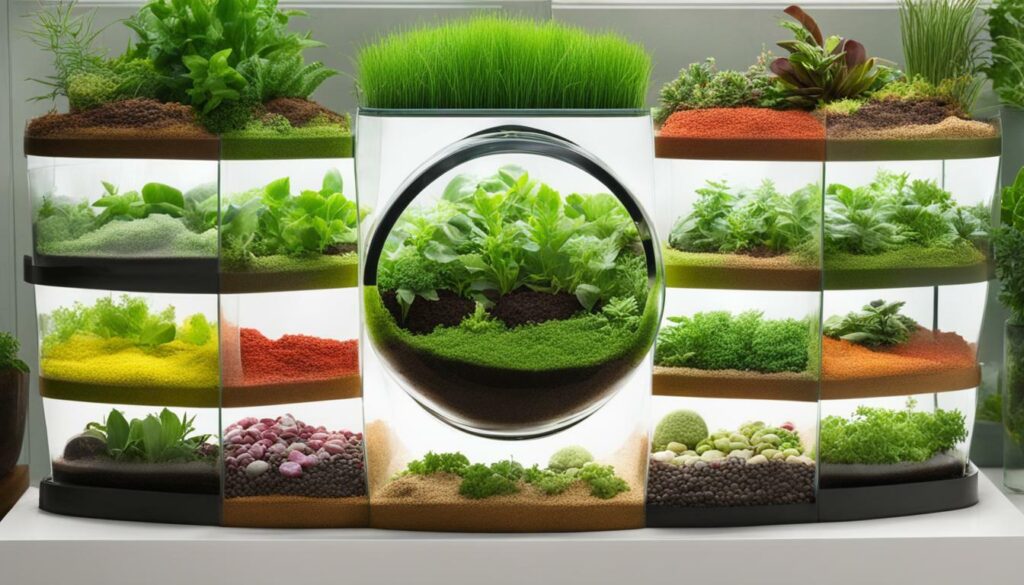
In summary, choosing the best fertilizers for your terrarium involves considering the specific needs of your plants and the type of terrarium setup. Organic fertilizers with balanced nutrient content are generally recommended, but it’s important to adjust the fertilizer type and ratio based on the plant species. By providing the right nutrients in a sustainable and responsible manner, you can ensure the long-term health and beauty of your terrarium.
Terrarium Fertilizing Techniques
Proper fertilizing techniques play a crucial role in maintaining healthy and thriving plants in your terrarium. By providing the necessary nutrients to your terrarium plants, you can ensure their optimal growth and vibrant appearance. Here are some essential tips for fertilizing your terrarium:
1. Choose the right fertilizer: Selecting the appropriate fertilizer is essential for the well-being of your terrarium plants. Consider using a balanced, slow-release fertilizer that provides a steady supply of nutrients over time. Look for a fertilizer specifically formulated for terrarium plants, ensuring it contains essential elements such as nitrogen, phosphorus, and potassium.
2. Follow the fertilizing schedule: Establish a regular fertilizing schedule to provide consistent nourishment to your plants. Consider fertilizing your terrarium every few months or as recommended by the specific fertilizer’s instructions. However, be cautious not to over-fertilize, as this can lead to nutrient imbalances and harm your plants.
“Using a balanced, slow-release fertilizer specifically formulated for terrarium plants is key to their health and growth.”
3. Apply the fertilizer correctly: When fertilizing your terrarium, follow the instructions provided by the fertilizer manufacturer. Dilute the fertilizer in water according to the recommended ratio and apply it to the soil around the plant’s base. Avoid direct contact with the leaves, as it may cause leaf burn or damage.
4. Monitor and adjust: Regularly monitor the condition of your plants and the overall health of your terrarium. If you notice signs of nutrient deficiency, such as yellowing leaves or stunted growth, it may be necessary to adjust your fertilizing regimen. However, be mindful not to overcorrect and create nutrient excess.
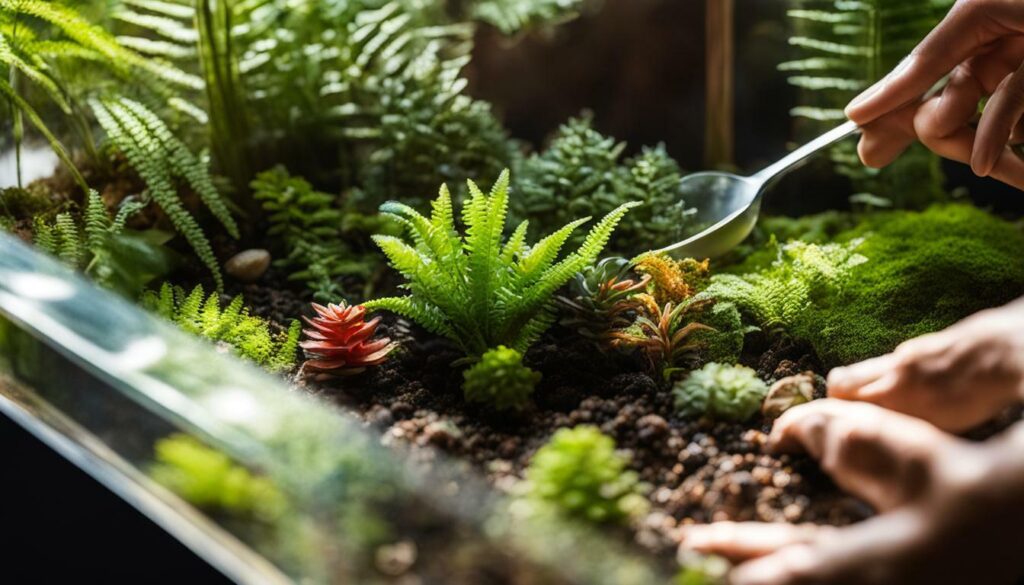
By following these fertilizing techniques, you can provide the necessary nutrients to your terrarium plants and promote their overall health and vitality. Remember to choose the right fertilizer, follow a consistent schedule, apply the fertilizer correctly, and monitor your plants’ response to make any necessary adjustments. With proper fertilizing, your terrarium will flourish with lush greenery and thriving plants.
Balancing Fertilization in a Bioactive Terrarium
Fertilization in a bioactive terrarium requires careful attention to maintain a harmonious environment for your plants while minimizing the risk of imbalances. Just like in any garden, providing the right nutrients is essential for the health and growth of your terrarium plants. However, in a bioactive setup, where beneficial insects and microorganisms play a crucial role in maintaining the ecosystem, it’s important to strike a balance to ensure the well-being of all inhabitants.
One approach to fertilizing bioactive terrariums is to rely on the natural processes within the enclosure. Pet waste, such as droppings from reptiles or amphibians, can serve as a natural fertilizer. The waste breaks down over time, releasing important nutrients into the soil. However, it’s important to monitor the soil conditions closely to avoid imbalances in nutrients. If the soil becomes too rich or acidic due to excessive waste, it can negatively impact plant health. In such cases, additional fertilization may be necessary.
When choosing fertilizers for a bioactive terrarium, it’s best to opt for organic options that are safe for the plants and the ecosystem. Organic fertilizers, derived from natural sources such as compost, fish emulsion, or worm castings, provide a slow-release of nutrients that plants can absorb gradually. This helps minimize the risk of overfertilization and allows for a more sustainable approach to nurturing your terrarium plants.
In addition to choosing the right fertilizers, it’s important to follow proper fertilizing techniques. Start by diluting the fertilizer according to the instructions on the packaging to avoid burning the plants’ roots. Apply the diluted fertilizer sparingly, focusing on the outer edges of the terrarium to prevent excessive buildup that could harm the delicate ecosystem. Regularly monitor the plants’ growth and appearance to evaluate if any adjustments are needed.
| Fertilizing Tips for Healthy Terrarium Plants |
|---|
| Monitor soil conditions to avoid imbalances caused by excessive waste. |
| Choose organic fertilizers for a sustainable approach. |
| Dilute fertilizers and apply sparingly to prevent overfertilization. |
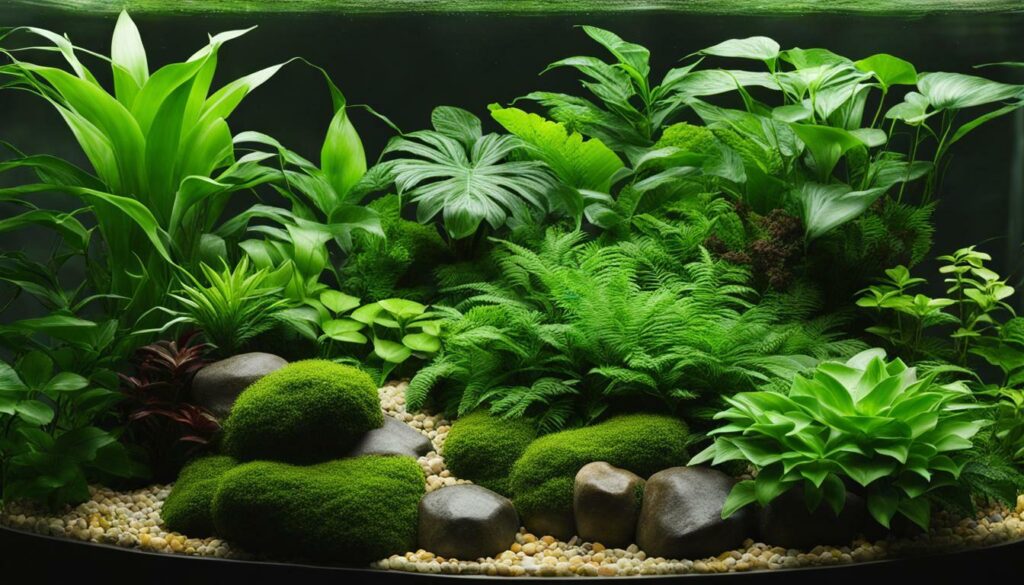
Remember, a bioactive terrarium is a delicate ecosystem, and maintaining the right balance is crucial for the long-term health of your plants. By carefully selecting fertilizers, following proper techniques, and monitoring the soil conditions, you can provide your terrarium plants with the nutrients they need while protecting the overall ecosystem.
The Role of Pruning in Terrarium Care
Pruning is a vital aspect of terrarium care that helps maintain healthy plants and encourages new growth. By selectively removing dead or overgrown foliage, you not only enhance the aesthetic appeal of your terrarium but also create space and resources for the remaining plants to thrive.
When pruning, it is important to use clean, sharp tools to minimize the risk of infection and ensure clean cuts. Trimming back excess growth not only improves the overall appearance of your terrarium but also prevents overcrowding, which can lead to competition for resources and hinder plant health.
Furthermore, pruning encourages new growth by stimulating dormant buds and diverting resources to healthier parts of the plant. Regular pruning also helps shape the plants within your terrarium, creating a more balanced and visually appealing arrangement.
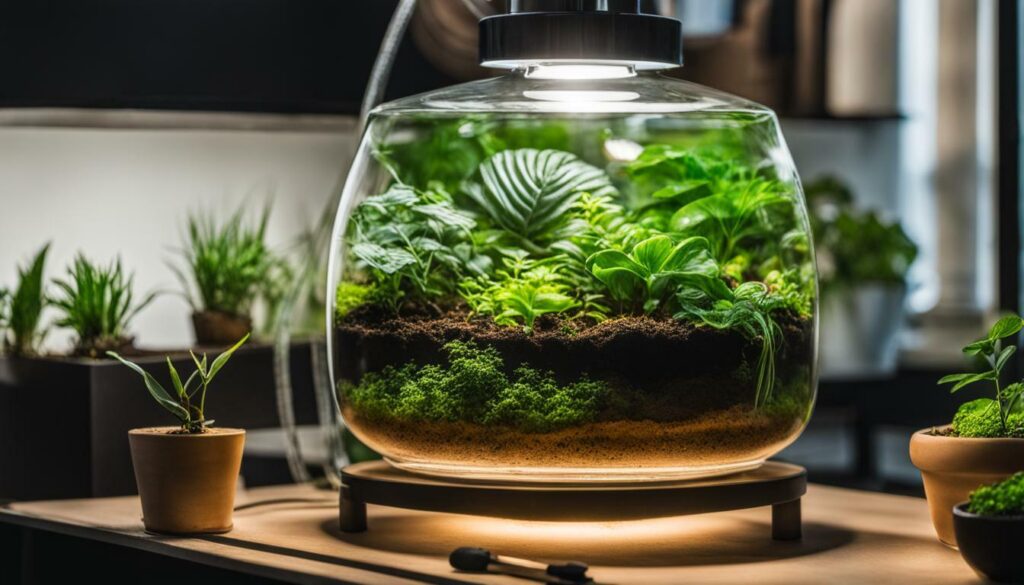
Best Practices for Pruning in Terrarium Care:
- Use clean, sharp tools to minimize the risk of infection.
- Remove any dead or yellowing foliage to maintain plant health and prevent the spread of disease.
- Trim back excessive growth to prevent overcrowding and encourage better air circulation.
- Regularly shape your plants by selectively pruning to create a visually appealing arrangement.
- Monitor your plants’ response to pruning and adjust as needed.
Remember, pruning should be done with care and consideration for the specific needs of your terrarium plants. It is always better to start with minimal pruning and gradually increase as needed, rather than removing too much foliage at once and risking stress or damage to the plants.
| Benefits of Pruning in Terrarium Care | How to Prune Terrarium Plants |
|---|---|
| 1. Promotes plant health and growth | 1. Use clean, sharp tools |
| 2. Enhances the aesthetic appeal of your terrarium | 2. Remove dead or yellowing foliage |
| 3. Prevents overcrowding and resource competition | 3. Trim back excessive growth |
| 4. Stimulates dormant buds and encourages new growth | 4. Shape your plants for a balanced arrangement |
Pruning plays a crucial role in maintaining the overall health and vitality of your terrarium plants. By following best practices and regularly monitoring your plants’ growth and response, you can ensure a thriving and visually stunning terrarium display.
Maintaining Clean Leaves for Optimal Photosynthesis
Clean leaves are essential for the successful photosynthesis of your terrarium plants, ensuring they receive the maximum amount of light and nutrients. Dust and debris can accumulate on the leaves, blocking sunlight and hindering the plants’ ability to produce energy. Additionally, dirty leaves can attract pests and promote the growth of harmful bacteria or fungi. To maintain clean leaves and promote optimal photosynthesis, consider the following tips:
- Misting: Regularly misting the leaves with clean water helps remove dust and keeps them clean. Use a spray bottle with a fine mist setting to gently spray the leaves, avoiding excessive moisture that can lead to fungal growth.
- Wipe Down: For larger terrarium plants with accessible leaves, you can use a soft, damp cloth or sponge to gently wipe down the leaves, removing any dirt or debris that has accumulated. Be gentle to avoid damaging the leaves.
- Pest Prevention: Keeping the leaves clean also helps prevent pests from infesting your terrarium. Insects are attracted to dirty leaves, so regular cleaning can deter them from taking up residence in your plants.
Remember to inspect your terrarium plants regularly for signs of pest infestation or disease. If you notice any issues, take immediate action to address them and prevent further damage. By maintaining clean leaves, you can ensure your terrarium plants receive the necessary light and nutrients for healthy growth.
Table: Cleaning Methods for Terrarium Leaves
| Method | Description |
|---|---|
| Misting | Using a spray bottle to mist the leaves with clean water, removing dust and debris. |
| Wipe Down | Gently wiping the leaves with a soft, damp cloth or sponge to remove dirt and debris. |
By incorporating these cleaning practices into your terrarium care routine, you can ensure that your plants thrive and maintain optimal photosynthesis. Remember to be gentle when cleaning the leaves to avoid causing any damage. With clean leaves, your terrarium will not only look more visually appealing but also support the health and growth of your plants.
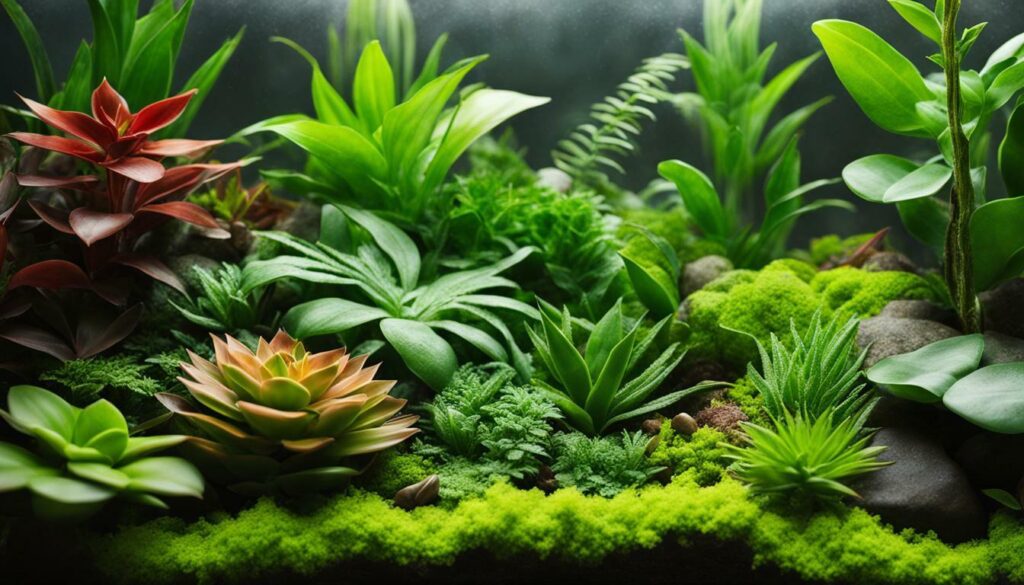
Closed terrariums require special consideration when it comes to fertilization, as their sealed environment necessitates a different approach to ensure plant health. While the enclosed nature of a closed terrarium helps create a self-sustaining ecosystem, it also means that the available nutrients can become limited over time. To address this, it is important to choose the right fertilizers and monitor the soil conditions regularly.
When setting up a closed terrarium, select a clear container that allows sunlight to enter and supports photosynthesis. Use a soilless potting mix with low fertility to prevent excessive nutrient buildup that could lead to imbalances and plant stress. It is essential to choose plants that are well-suited to the light and moisture conditions of the terrarium to ensure their long-term health.
Once your closed terrarium is established, it requires minimal maintenance. However, occasional watering and cleaning are still necessary to maintain a healthy environment. Keep an eye on the moisture levels in the soil, as overwatering can lead to root rot and other issues. It is important to only provide water when the soil feels dry to the touch, as different plants have different water requirements.
After about a year, you may need to consider fertilizing your closed terrarium. The closed environment limits the availability of external nutrients, so adding a slow-release fertilizer specifically formulated for terrariums can help replenish the nutrients that may have been depleted over time. However, it is crucial to follow the product’s instructions and use a minimal amount of fertilizer to avoid overfeeding your terrarium plants.
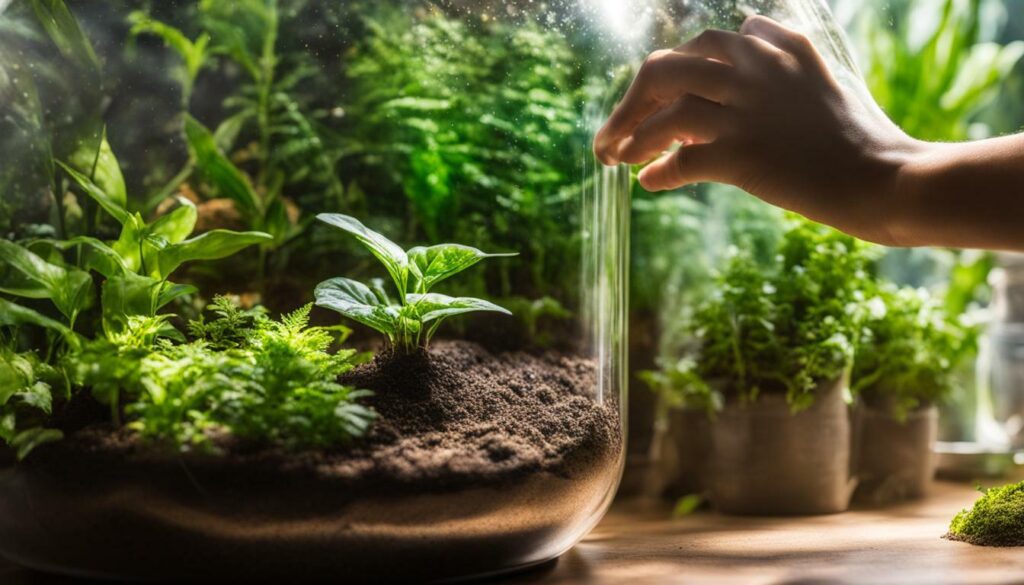
| Special Considerations for Closed Terrarium Fertilization: | Recommended Actions: |
|---|---|
| Choose a clear container | Allows sunlight to enter and supports photosynthesis |
| Use a soilless potting mix with low fertility | Prevents excessive nutrient buildup and imbalances |
| Select plants suitable for the terrarium’s light and moisture conditions | Ensures long-term plant health |
| Monitor soil moisture levels | Water only when the soil feels dry to the touch |
| Add slow-release fertilizer formulated for terrariums if needed | Replenishes depleted nutrients without overfeeding |
Maintaining a Closed Terrarium: Minimal Maintenance and Possible Fertilization
Once established, closed terrariums are relatively low-maintenance; however, periodic care and potential fertilization are necessary to sustain the long-term health of the plants. While closed terrariums create a self-sustaining ecosystem where plants recycle moisture, nutrients, and oxygen, there are a few key considerations to ensure their continued success.
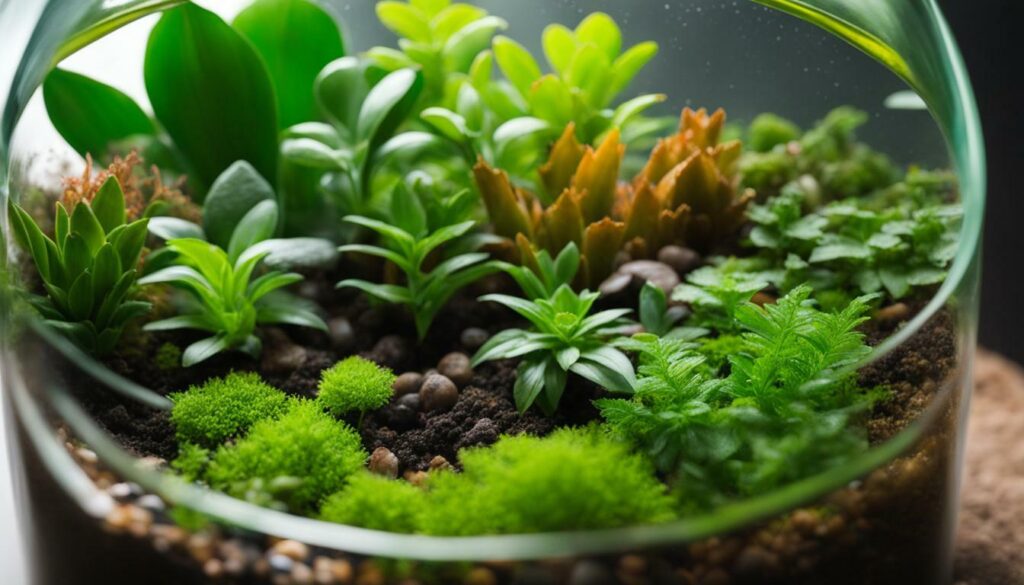
Firstly, monitoring the soil moisture is crucial for closed terrariums. The closed environment can create high humidity levels, reducing the need for frequent watering. However, it is important to check the soil regularly to ensure it remains moist but not waterlogged. Overwatering can lead to root rot and mold growth, while underwatering can cause the plants to wither and die.
Secondly, occasional cleaning is necessary to remove dust from the terrarium and keep the glass clear for optimal light penetration. Gently misting the plants or wiping down the leaves with a damp cloth can help remove any accumulated dust and improve photosynthesis. This simple maintenance task will help keep the plants healthy and vibrant.
Lastly, while closed terrariums recycle nutrients through a natural process, over time, the soil may become depleted. In such cases, adding a small amount of liquid fertilizer can help replenish the essential nutrients necessary for the plants’ growth. However, it is crucial to use a diluted solution and follow the instructions carefully to avoid over-fertilization, which can harm the delicate ecosystem within the terrarium.
Summary:
- Monitor soil moisture regularly to ensure it stays moist but not waterlogged.
- Clean the terrarium periodically to remove dust and promote optimal light penetration.
- Consider adding a diluted liquid fertilizer if the soil becomes depleted.
| Pros | Cons |
|---|---|
| Low-maintenance once established | Requires periodic care and potential fertilization |
| Self-sustaining ecosystem | Can be prone to overwatering or underwatering |
| Recycles moisture, nutrients, and oxygen | May require occasional cleaning |
How Does Soil Maintenance in a Terrarium Affect Fertilizing Practices?
Mastering terrarium soil maintenance is crucial for proper fertilizing. Good soil structure allows nutrients to reach plant roots effectively, reducing the need for excessive fertilization. It also promotes healthy microorganism activity, aiding in nutrient uptake. Maintaining balanced soil moisture is vital for overall plant health, making regular soil inspection and maintenance essential.
Conclusion
With the knowledge and implementation of proper fertilizing techniques, you can ensure the health and vitality of your terrarium plants, creating a lush and thriving ecosystem.
Creating and maintaining a terrarium requires understanding the specific needs of your plants, including factors such as light, soil, and water. Providing adequate light is crucial for plant growth, as insufficient light can result in sparse growth and undersized leaves. In a terrarium environment, it is generally difficult to give plants too much light, so strive to provide as much as possible within their recommended range.
The soil in your terrarium serves as the foundation for plant growth and acts as a reservoir for water and nutrients. Different plants have varying soil preferences, so choose a soil type that suits their specific needs. Additionally, monitoring soil moisture levels is essential as over or under watering can harm your plants. Regularly check the soil moisture and adjust your watering schedule accordingly.
In a bioactive terrarium setup, pet waste can serve as a natural fertilizer. However, it’s important to note that imbalances can occur, so monitoring the soil conditions and adding fertilizer if necessary is crucial. Regular pruning helps maintain healthy plants and promotes growth, while keeping the leaves of your terrarium plants clean is essential for optimal photosynthesis. Consider misting or wiping down leaves to remove dust and debris.
When creating a closed terrarium, choose a clear container that allows light to penetrate. Use a soilless potting mix with low fertility to prevent excessive growth and select plants that are suitable for the light and moisture conditions within the terrarium. Once established, a closed terrarium requires minimal maintenance, with occasional watering and cleaning. After a year, you may need to consider fertilizing your terrarium plants to replenish nutrients.
By following these best practices and understanding the unique needs of your terrarium plants, you can create a thriving ecosystem that brings beauty and tranquility to your home or office space.
FAQ
How much light do terrarium plants need?
It is generally hard to give a plant too much light in a terrarium environment. Signs of not enough light include sparse growth and undersized leaves.
What type of soil should I use for my terrarium?
Different plants prefer different soil types. The soil should provide a foundation for growth and act as a reservoir for water and nutrients.
Can I use pet waste as fertilizer in a terrarium?
In a bioactive setup, pet waste can serve as a natural fertilizer. However, imbalances can develop, so monitoring the soil and adding fertilizer if needed is important.
How often should I water my terrarium?
Different plants have different water requirements, so knowing your plants’ needs and monitoring soil moisture is crucial for proper watering.
Is pruning necessary for terrarium plants?
Yes, regular pruning helps maintain healthy plants and promote growth in a terrarium.
How do I keep the leaves of my terrarium plants clean?
Keeping plant leaves clean is important for photosynthesis. You can mist or wipe down the leaves to maintain their cleanliness.
What should I consider when creating a closed terrarium?
When creating a closed terrarium, choose a clear container, use a soilless potting mix with low fertility, and select plants that suit the light and moisture conditions of the terrarium.
How much maintenance does a closed terrarium require?
Once established, a closed terrarium requires minimal maintenance, with occasional watering and cleaning. Fertilization may be needed after a year.

